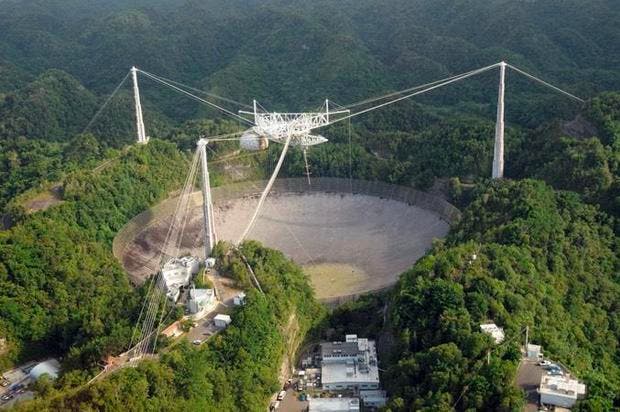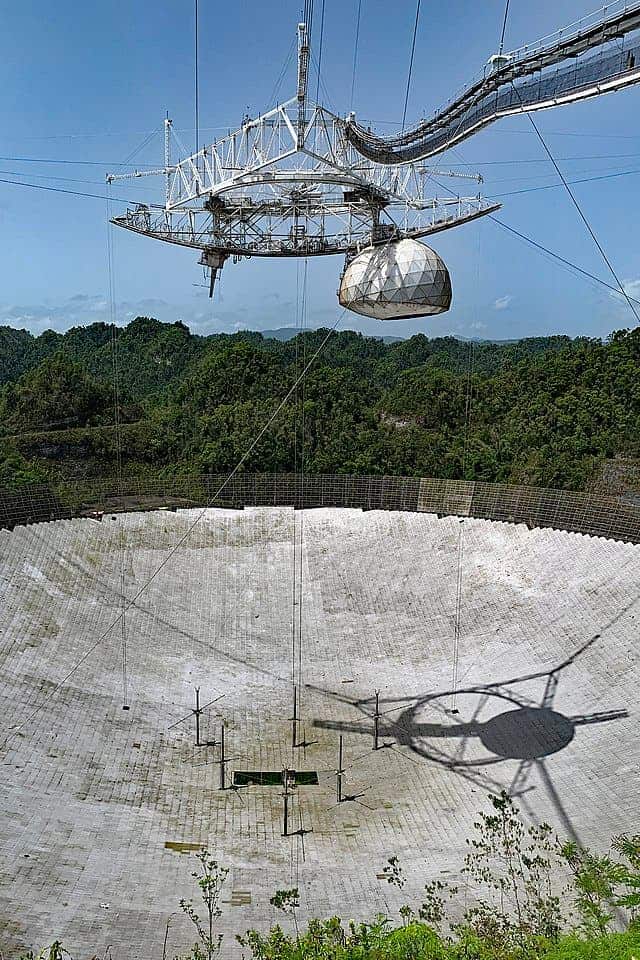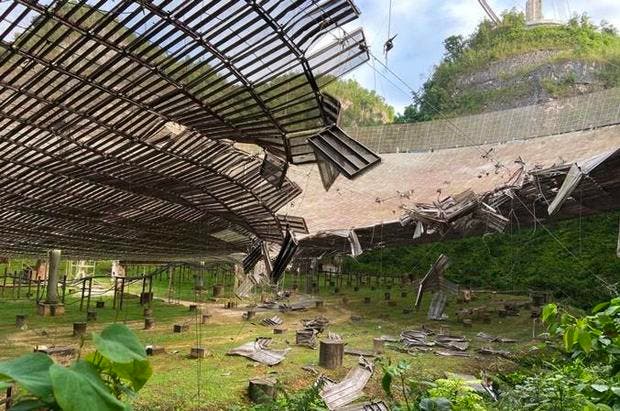Less than two weeks after officials announced it’s too dangerous to attempt repairs, the Arecibo telescope has completely collapsed. The 900-ton platform of the world’s second-largest single-dish radio has broken down, leaving the telescope unrepairable.
Staff member Jonathan Friedman, who lives near the telescope, reported to the Associated Press that he heard a large rumble and rushed to the telescope. When he reached the top of a nearby hill, he saw the collapsed structure and a cloud of dust rising from it.
“It sounded like a rumble. I knew exactly what it was,” he told AP. “I was screaming. Personally, I was out of control… I don’t have words to express it. It’s a very deep, terrible feeling.”
The Arecibo Observatory’s main feature was the huge radio telescope. Built inside a karst sinkhole, the telescope had a shape of a spherical cap 1,000 feet (305 m) in diameter. Astronomers would brag that Pierce Brosnan was too afraid to run up the telescope in the James Bond movie — something they do every day. It had almost 40,000 perforated aluminum panels supported by a mesh of steel cables.
The neglect of these cables are what ultimately brought its demise.

It started with a cable break in August 2020, which threatened the structural integrity of the whole structure. Another break in November 2020 made it too dangerous to repair the telescope. Each cable was made of 160 wires but drone footage of the remaining cables showed that these wires were breaking almost daily.
The National Science Foundation (NSF), who manages the telescope, announced that it would start dismantling the telescope, while still supporting the other on-site facilities, such as the LIDAR facility for geospace research and the Ángel Ramos Foundation Visitor Center.

The platform was built in the 1960s, but several instruments were added in the 1990s, making the entire structure much heavier. Even so, it’s not clear exactly why the structure collapsed, as it was still active and undergoing active maintenance.
“[It] should not have failed the way it did,” says Ashley Zauderer (NSF), according to Sky and Telescope. “The team is looking very closely at why that happened.”
“Our focus is now on assessing the damage, finding ways to restore operations at other parts of the observatory, and working to continue supporting the scientific community, and the people of Puerto Rico,” says NSF director Sethuraman Panchanathan.
Twitter user Deborah Martorell also shared a photo of the collapsed structure.
The telescope will now be dismantled. The NSF is under contract to return the site to its original natural state. There seems to be no plan for rebuilding the telescope or replacing it with another scientific instrument. Not much (if anything) can be saved from the scientific equipment.
Many scientists and Puerto Ricans mourned the announcement, with some tearing up during interviews.
The Arecibo telescope was still doing good science
Arecibo was very storied during the SETI days, but while those days are long behind, the telescope was still very active in recent years. Arecibo was the first radio telescope to discover a repeating Fast Radio Burst (FRB), it helped us better understand our planetary neighbors, and even gave us the discovery of the first binary pulsar, which was offered a Nobel Prize.
In recent days, however, the NSFW was struggling to get the funding to properly maintain it. In 2017, Arecibo faced closure after the NSF found its budget hacked and slashed. Radio astronomy funding in general is struggling in the US. It’s still speculation at this point, but this underfunding may very well be a cause for the telescope’s collapse.
It’s a sad day for science when, after surviving hurricanes and earthquakes, a landmark telescope collapses due to underfunding and neglect. Our understanding of the universe will be a little bit poorer after the collapse of this telescope.



